A Guide to Its Names, Origins, and Uses
Table of Contents
Toggle- A Guide to Its Names, Origins, and Uses
- The Global Nomenclature of Black Marble: A Categorization of Famous Varieties
- The Science of Black Marble: A Deep Dive into Geology and Mineralogy
- Practical Considerations: Care, Durability, and Applications
- Market Dynamics: Rarity, Pricing, and Sourcing
- The Future of Natural Stone: Technology, Sustainability, and Regulation
- Conclusion
The Global Nomenclature of Black Marble: A Categorization of Famous Varieties
Black marble does not have a single “scientific” or “common” name in the stone industry; instead, its nomenclature is typically tied to its quarry of origin, its visual characteristics, or a commercial brand name. For example, a variety from Spain might be known as Nero Marquina, while one from Italy could be called Nero Portoro. These names themselves carry information about their source and distinct aesthetic. A systematic examination of these famous varieties is the first step toward understanding the world of black marble.
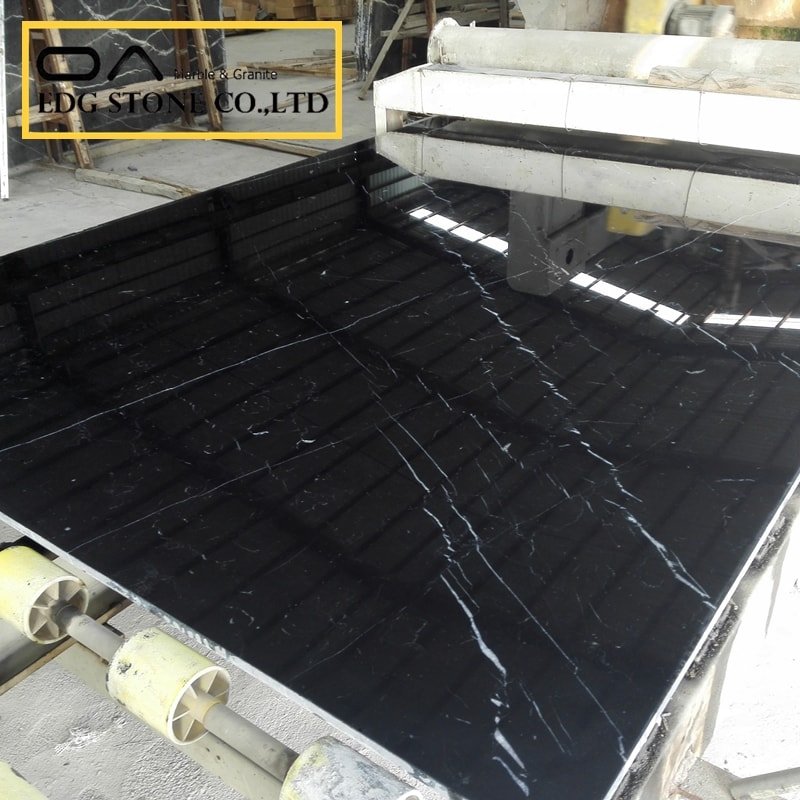

The Spanish Masterpiece: Nero Marquina
Nero Marquina, also referred to as Marquina Black or Negro Marquina, is one of the world’s most recognizable black marbles, with a significant international reputation.1 It originates from the Basque Country in northern Spain, specifically from quarries in the town of Markina. The stone is celebrated for its intense, uniform black background and striking white veining, which varies in thickness and intensity to give each slab a unique pattern. The bold aesthetic of Nero Marquina makes it an excellent choice for creating a dramatic visual impact in interiors, suitable for countertops, flooring, and wall cladding in both classic and modern designs. Due to its high production volume, this variety is often considered one of the most accessible and cost-effective black marbles on the market, offering a great balance of quality and availability.
The Italian Icon: Nero Portoro
Nero Portoro, quarried in Italy, is widely regarded as one of the world’s most prestigious black marbles, with a history of value that dates back to its manual extraction in the 7th and 8th centuries. This stone is distinguished by its jet-black background and dynamic, irregular golden and white veining. These unique patterns can form a natural “mosaic” or “leopard pattern,” making each slab highly individualized. The luxurious appearance of Nero Portoro makes it a preferred choice for high-end applications, particularly in luxury residential and commercial spaces, including feature walls, opulent flooring, and exquisite countertops. Its rarity and unique structure contribute to its status as one of the most expensive black marbles globally.
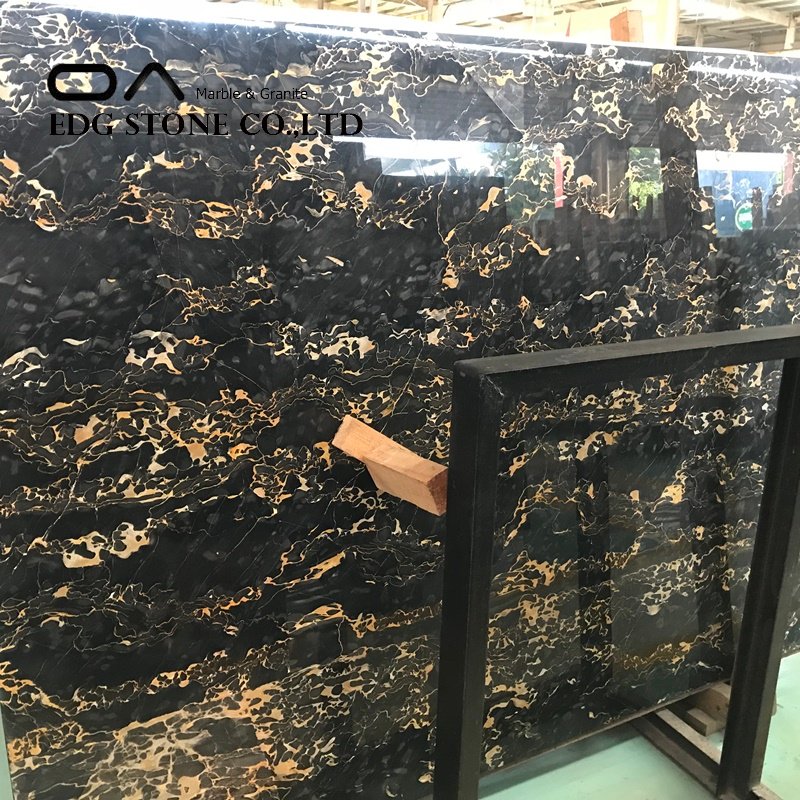
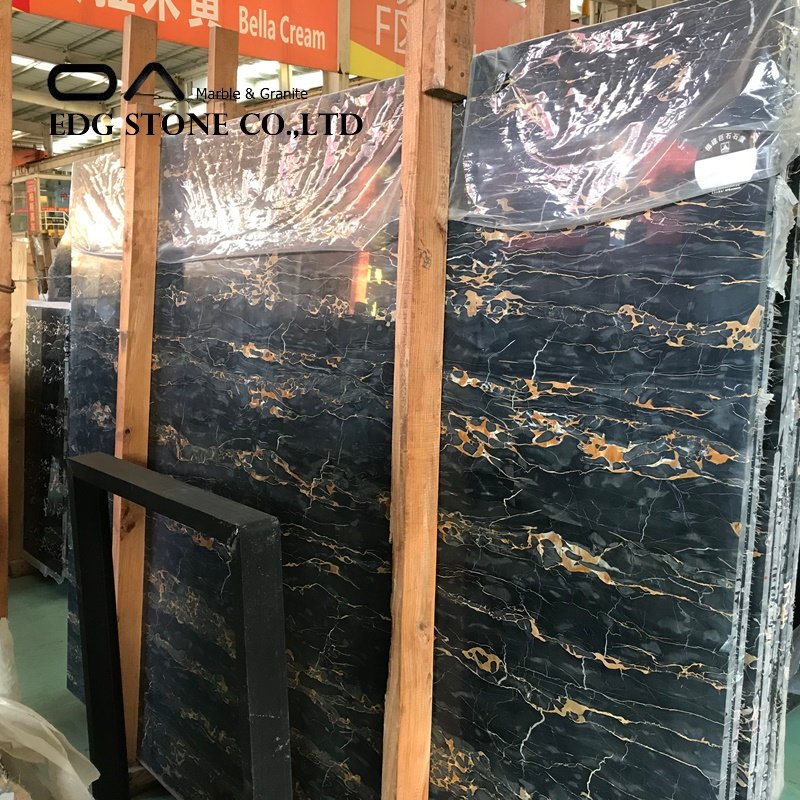
French Classics and Moroccan Gems
Beyond the Spanish and Italian icons, other black marbles are found in captivating varieties around the world:
- Noir Saint Laurent: A dark marble from France, characterized by a crystalline black background with delicate brown, white, and golden veining, and occasionally fossils. Some sources also place its origin in the Agadir-Biougra region of Morocco,12, highlighting its complex commercial sourcing. Its aesthetic is often best accentuated with opaque, matte, or honed finishes.
- Port St Laurent: This variety from Morocco is known for its deep black color blended with golden and brown tones. The stone’s unique veining often creates a combination of swirls and veins, making it an excellent choice for creating dramatic effects.
- Fossil Black: Also from Morocco, this type is distinguished by the presence of ancient fossils embedded within its dark surface. These fossils add a layer of historical intrigue and unique texture, making it a favorite for interior design projects that seek to incorporate a sense of natural history.
Global Naming and Origin Discrepancies
A systematic look at black marble reveals an important industry phenomenon: the commercial name of a stone does not always correspond to its geographical origin. For instance, some varieties sold as “Athens Portoro” actually come from Yunnan Province in China, not Greece.14 Similarly, the “Afghan Portoro” quarry is located in the Balochistan province of Pakistan, not Afghanistan.
This naming convention is common in the international stone trade, often used to evoke a particular aesthetic or cultural association (e.g., “Athens” for classical beauty, “Italian” for luxury) rather than a simple geographical marker. For uninformed buyers, this practice can lead to confusion, as they may believe they are purchasing a more expensive or prestigious variety, when in reality they are getting an alternative from a different region with potentially varying quality or characteristics. Therefore, understanding the true origin behind a stone’s name is crucial for making informed procurement decisions.
Table 1: Key Black Marble Varieties and Their Characteristics
Name | Origin | Veining/Color | Primary Use |
Nero Marquina | Spain | Pure black background with white veins | Countertops, flooring, and all cladding |
Nero Portoro | Italy | Jet-black background with dynamic golden and white veins | Luxury interiors, feature walls, high-end countertops |
Noir Saint Laurent | France/Morocco | Black background with brown, white, and golden veining, sometimes with fossils | Countertops, wall cladding, and flooring |
Port St Laurent | Morocco | Black background with a mix of golden and brown veining | Flooring, countertops, decorative applications |
Fossil Black | Morocco | Black background with embedded ancient fossils | Flooring, countertops, and unique projects |
Athens Portoro | China | Dark black background with gold mesh-like veins | Countertops, vanity tops |
Black and Gold | Pakistan | Black background with golden striped veining | Flooring, cladding, border lines |
The Science of Black Marble: A Deep Dive into Geology and Mineralogy
To truly understand black marble, one must look beyond its name and delve into its geological origins and its nature as a rock.
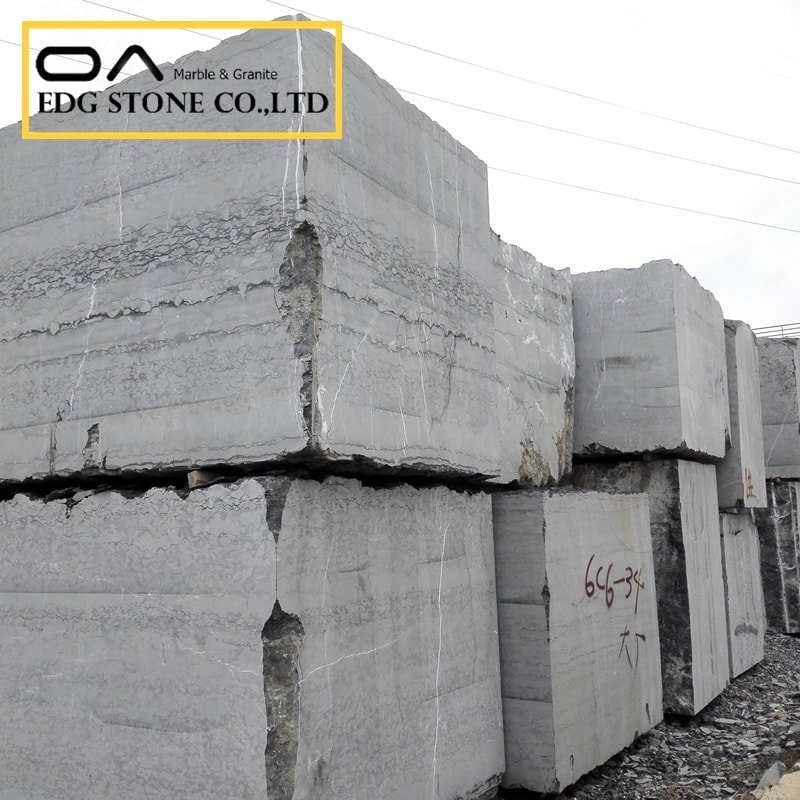
Geological Definition: The Formation of a Metamorphic Rock
Marble is a metamorphic rock. It forms when limestone, a sedimentary rock, is exposed to high temperatures and pressures deep within the Earth’s crust. In this extreme environment, the calcite crystals that make up the limestone recrystallize, forming a more compact rock consisting of interlocking, roughly uniform crystals. This process fundamentally differentiates it from its parent rock, which is a sedimentary stone formed from the solidification of sediment.
Scientific Identity: Calcium Carbonate (CaCO3)
Chemically, the primary component of marble is calcium carbonate.20 Its chemical formula is
CaCO3, which means each molecule contains one atom of calcium, one of carbon, and three of oxygen. Calcium carbonate is a non-toxic, naturally occurring compound that is the main mineral in limestone and chalk. While the bulk of marble is calcium carbonate, certain varieties can also contain dolomite (calcium-magnesium carbonate).
The Source of Color: Why Is Black Marble So Deep?
The dark color of black marble is not from its main mineral, calcite. Instead, it is a result of specific impurities trapped during its formation. The color is primarily attributed to a high concentration of organic debris, bitumen, and sulfides that were deposited on continental platforms in ancient anoxic (oxygen-deprived) environments millions of years ago. It is this unique, ancient geological context that gives black marble its distinctive, rich coloration.
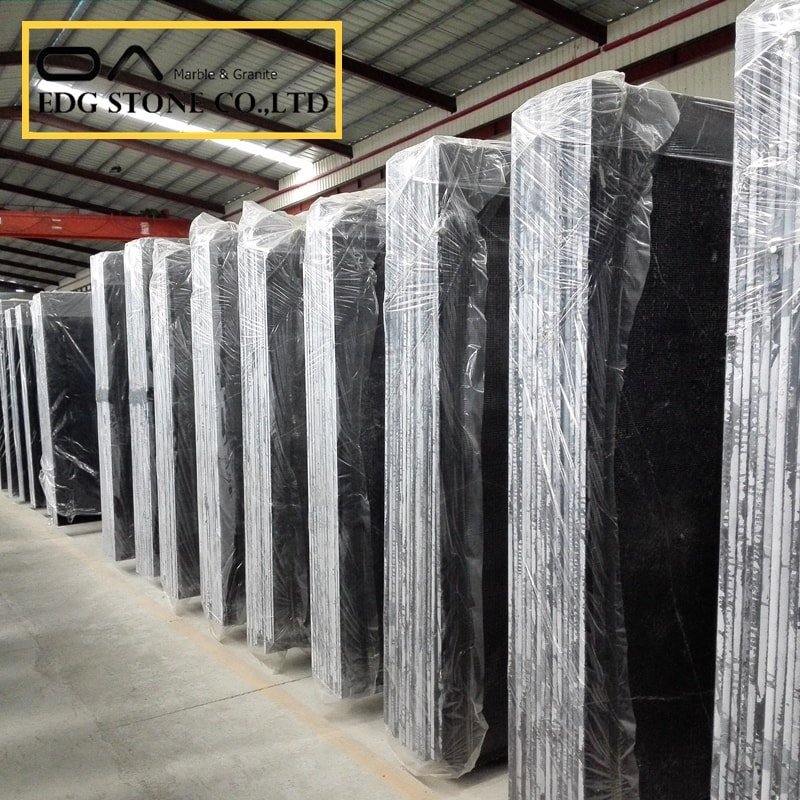
The Essential Difference Between Metamorphic Marble and Sedimentary Limestone
Despite being formed from limestone, marble and its parent rock have a fundamental difference in their physical properties. Limestone is composed of fossil fragments and a calcite matrix, with small voids between them that make it more porous. Marble, on the other hand, undergoes recrystallization where its calcite crystals lock together like pieces of a jigsaw puzzle, creating a rock that is denser and less porous.
A closer look at this geological process reveals a key link to the stone’s performance. Some research suggests that darker marbles are often softer and more prone to wear and tear than their white or beige counterparts. This seems to be related to the concentration of organic matter that gives it its dark color. While the metamorphic process makes it more compact, the organic-rich limestone from which it forms may result in a relative susceptibility to scuffing and deterioration. This direct relationship between its mineralogical makeup and its physical durability is a critical factor for professionals to consider when specifying the material.
Practical Considerations: Care, Durability, and Applications
Moving from geology to practical application, the physical properties of black marble dictate its performance in projects and the daily maintenance it requires.
The Black Marble vs. Granite Debate: A Comparison of Durability and Maintenance
In interior design and architecture, black marble is often compared to granite, especially for high-use areas like kitchen countertops.
- Durability: Marble is a relatively softer and more porous natural stone, making it more susceptible to scratching, chipping, and etching. It is particularly sensitive to acidic substances, such as wine, citrus juice, or coffee, which can leave dull, rough marks on the surface. In contrast, granite is an igneous rock that scores higher on the Mohs hardness scale, making it more resistant to scratches and chips
- Maintenance: Due to its porous nature, marble is more prone to staining than granite, and therefore requires more frequent sealing, typically once or twice a year, depending on use. Granite, which is less porous, generally only needs to be sealed every two to five years.
While granite may appear to be a more practical and durable choice, the stunning aesthetic and unique character of black marble ensure its continued popularity in high-end applications. This enduring appeal shows that for the target audience, the design value of luxury, elegance, and drama often outweighs the maintenance needs and practical limitations of the material.
A Guide to Daily Care and Proactive Protection
Proper care is key to preserving the beauty and longevity of black marble. Here are some core principles:
- Avoid Acidic and Abrasive Cleaners: The calcium carbonate in black marble reacts with acids, which can cause chemical etching and loss of shine. Therefore, you must completely avoid using vinegar, lemon juice, acidic household cleaners, and any abrasive products. Instead, use only a pH-neutral stone-specific cleaner and a soft, damp cloth for daily cleaning.
- Clen Spills Immediately: Any acidic spills like wine, coffee, or soda should be wiped up immediately with a soft cloth to prevent etching.
- Professional Care: It is recommended to have marble professionally sealed periodically, and to get it buffed and resealed every 3-5 years to restore its shine and protective layer. For flooring and high-traffic areas, a process called densification can be used to penetrate deep into the stone’s pores and make it more resistant to wear.
Key Considerations: Limitations and Drawbacks
Despite its unmatched beauty, black marble’s inherent physical properties also come with some limitations.5 Its dark color can absorb and retain heat, and placing a hot pot or pan directly on the surface can cause “thermal shock” and damage. Additionally, black marble is generally not recommended for outdoor applications, as prolonged exposure to harsh weather and UV rays can cause its color to fade and the stone to deteriorate over time.
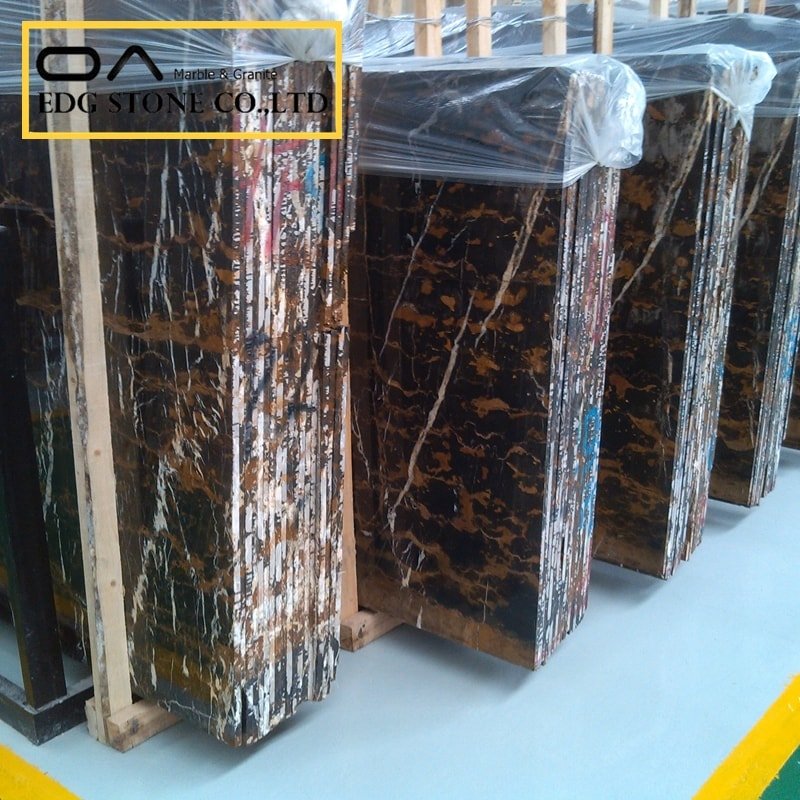
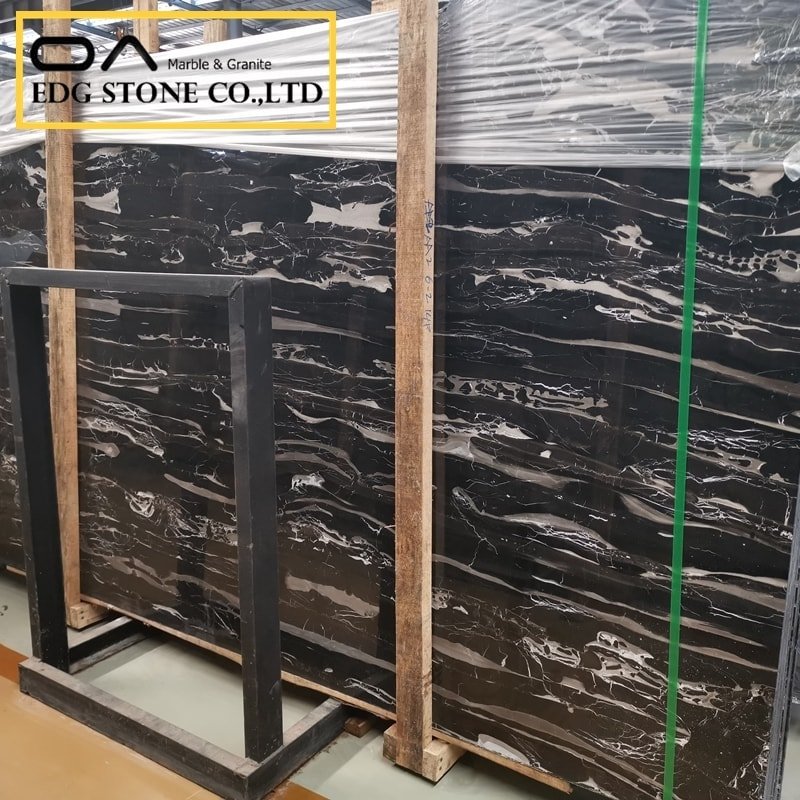
Market Dynamics: Rarity, Pricing, and Sourcing
The commercial value of black marble is closely tied to its rarity, origin, and market supply and demand. Understanding these dynamics is essential for a savvy buyer.
The Rarity of Black Marble
While white, gray, and black marbles are common in interior design, black marble varieties with gold veining are considered rare and highly sought after. For instance, Nero Portoro is one of the most expensive varieties in the world because of its unique combination of golden veining. Furthermore, some varieties like Nero Portoro Fino Extra are becoming increasingly rare due to their thin veining and superior quality, which further drives up their market value.
From Quarry to Countertop: A Global Supply Chain Analysis
The pricing of black marble is layered, depending on the variety, country of origin, and processing format, creating a tiered market:
- The Luxury Tier: Italy’s Nero Portoro is the undisputed top-tier variety, with its rarity and historical prestige placing it at the highest end of the price spectrum.
- The High-Quality Alternative Tier: China’s “Athens Portoro” is a high-quality alternative to the Italian variety, with a solid structure and a more moderate price.
- The Economical Tier: Pakistan’s “Afghan Portoro” is often the most economical choice, though its slabs may have fissures and are generally not suitable for large countertops, making them better for tiles and smaller applications.
This tiered market structure offers professional buyers flexible options to meet various project budgets. Instead of being limited to the most expensive choices, they can deliberately select aesthetically similar but more competitively priced alternatives, maximizing cost-effectiveness without sacrificing their design vision.
Sourcing can occur through various channels, including directly from quarry owners (such as Polycor), large wholesalers (like EDG Stone, Architessa, and Vicostone), and consumer-facing retailers (such as Stone Tile Depot and Country Floors). Pricing can vary significantly based on the supplier, product format (slab vs. tile), and finish (polished vs. honed).
Table 2: Black Marble vs. Granite: Durability and Maintenance Comparison
Feature | Black Marble | Granite |
Mohs Hardness | Relatively soft (approx. 3-4) | Relatively hard (approx. 6-7) |
Porosity | Higher absorbs liquids more easily | Lower, more resistant to stains |
Etching Resistance | Sensitive to acids, prone to etching | Relatively resistant to acids |
Heat Resistance | Can absorb heat, susceptible to thermal shock | More resistant to high temperatures |
Daily Maintenance | Needs frequent sealing, pH-neutral cleaners only | Less frequent sealing, can tolerate slightly harsher cleaners |
The Future of Natural Stone: Technology, Sustainability, and Regulation
The natural stone industry is in an era of profound transformation, with its direction being shaped by technological advancements, sustainable practices, and increasingly stringent regulations.
The Imperative of Sustainable and Ethical Sourcing
A growing global environmental consciousness is pushing the stone industry towards more sustainable and ethical practices. This is reflected not only in the focus on the ecological footprint of quarrying but also in the push for designers to select durable stone that reduces the need for replacement, as well as the practice of “adaptive reuse,” where stone from old buildings is recycled and repurposed. This trend indicates that stone selection is no longer just an aesthetic consideration but a reflection of environmental responsibility.
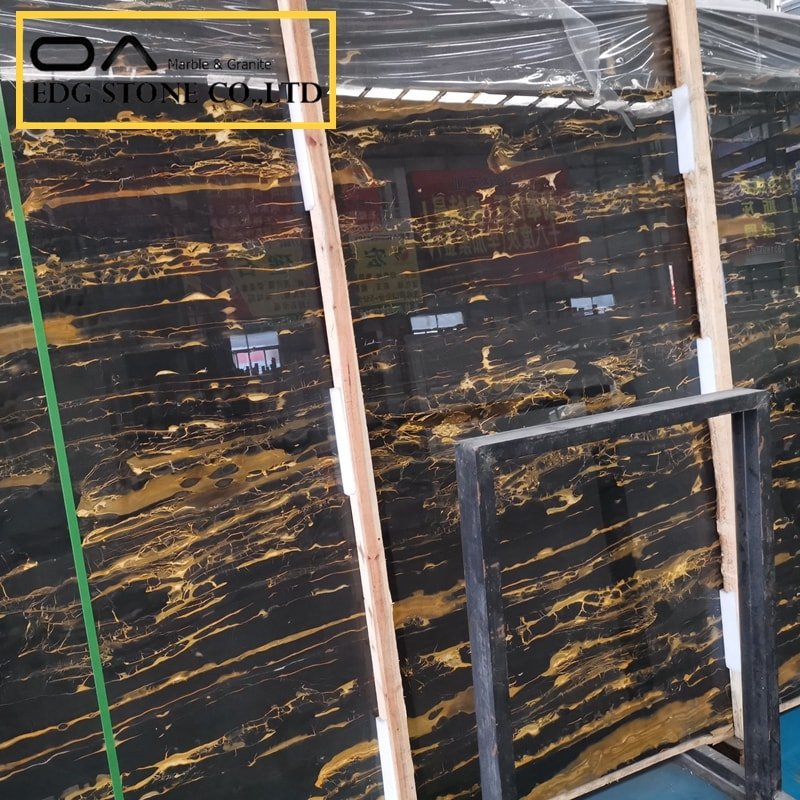
Responding to New Environmental and Safety Regulations
Increasingly strict regulations are shaping how quarries operate. For example, some jurisdictions require quarries to be surrounded by heavy-duty, seven-foot-high fences with gates to enhance security. Noise mitigation plans are also becoming mandatory, requiring the construction of sound barriers or landscaped berms at least 12 feet high to protect nearby residents. Furthermore, regulations like the U.S. Clean Water Act require quarry operators to build bridges and culverts over illegally diverted streams and perform ecological restoration to mitigate damage to water resources.
These regulations, which might appear to increase operational costs, are actually synergistic with technological advancements. The efficiency gains and cost savings from AI and automation provide the economic foundation for the stone industry to meet these compliance challenges. By reducing material waste, increasing production efficiency, and improving quality control, technology is not just a tool for profitability but a strategic enabler for compliant and responsible operations.
Conclusion
This report has provided an in-depth look at the fascinating material that is black marble. Geologically, it is a metamorphic rock formed from limestone, with its dark color derived from ancient organic matter. Its commercial names, such as Nero Marquina and Nero Portoro, are often tied to its unique aesthetic and geographic origin. In practice, while it requires more maintenance than materials like granite, its unparalleled luxury and elegance ensure its enduring place in high-end design. From an industry perspective, technological advancements like AI and automation are working in tandem with new environmental regulations to drive the natural stone sector toward a more efficient and sustainable future.
FAQ: Google Hot Search Questions
What is the difference between black marble and black limestone?
Black marble is a metamorphic rock formed when black limestone recrystallizes under high heat and pressure. This process makes the marble’s crystal structure more compact and less porous than its parent rock, black limestone, which is a sedimentary rock composed of fossil fragments.
Is black marble difficult to maintain?
Yes, black marble requires more care than other stones like granite. It is a relatively soft and porous material that is susceptible to etching from acids and can be scratched easily. To prevent damage, spills must be wiped up immediately, and it needs to be cleaned with pH-neutral products and sealed annually or more frequently.
Can black marble be used outdoors?
Black marble is not typically recommended for outdoor applications. Prolonged exposure to harsh weather conditions and UV rays can cause the stone to fade and deteriorate over time.
Is black marble a good choice for kitchen countertops?
Black marble can be an excellent choice for kitchen countertops due to its ability to create a luxurious and dramatic look. However, because it is softer and more prone to etching than granite, it requires more diligent maintenance, including immediate spill cleanup and regular sealing.
Which black marble is the most luxurious?
Nero Portoro is often considered the most luxurious black marble in the world. It is known for its deep black background and distinctive golden and white veining, which makes it ideal for high-end and luxury applications.
SEO Tags: black marble names, famous black marble, nero marquina, nero portoro, what kind of rock is black marble, black marble manufacturer, black marble factory, black marble wholesale, black marble rarity, black marble maintenance, black marble durability, black marble vs granite, black marble scientific name, sahara noir, noir saint laurent, fossil black, marble industry trends, ethical sourcing stone, marble quarry regulations, black marble properties, is black marble natural, black marble types, how to care for black marble, black marble countertops, black marble flooring, black marble applications, is black marble porous, how to clean black marble, black marble geological formation, black marble vs limestone, most expensive black marble, nero portoro vs nero marquina, nero marquina origin, italian black marble, spanish black marble, black marble with gold veins, black marble with white veins, black marble with fossils, black stone names, marble vs granite durability, marble porosity, marble cleaning tips, marble slab price, luxury black marble, marble sourcing direct, marble quarrying process, marble sustainability, AI in stone industry, stone industry regulations, black marble for home, black marble for kitchens, black marble for bathrooms.
